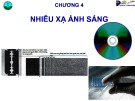
HPU2. Nat. Sci. Tech. Vol 03, issue 03 (2024), 35-42.
HPU2 Journal of Sciences:
Natural Sciences and Technology
Journal homepage: https://sj.hpu2.edu.vn
Article type: Research article
Received date: 09-7-2024; Revised date: 29-9-2024 ; Accepted date: 05-11-2024
This is licensed under the CC BY-NC 4.0
35
The one-pot fabrication of green-emitting composites based on PMMA
Mohapatra Priyaranjan
a
, Xuan-Bach Nguyen
b
, Thuy-Trang Pham
b
, Sinh-Hung Nguyen
b
, Huy-
Hoang Bui
b
, Ba-Trang Doan
b
, Kim-Dat Ha
b
, Duc-Nam Cao
b
, My-Anh Nguyen Thi
b
, Minh-Anh
Nguyen
b
, Le-Duc Nguyen
b
, Van-Phong Bui
b
, Van-Hao Nguyen
c
, Quang-Bac Hoang
b
*
a
Veer Surendra Sai University of Technology, Odisha, India
b
Hanoi Pedagogical University 2, Vinh Phuc, Vietnam
c
Institute of Science and Technology, TNU-University of Sciences, Thai Nguyen, Vietnam
Abstract
Photoluminescent composites consisting of a photoluminescent material dispersed in a suitable matrix
have been applied in many applications, such as light-emitting diodes, solar concentrators, and anti-
counterfeiting inks. The traditional method for the fabrication of composites by blending an as-
synthesized photoluminescent material and a matrix is very challenging as it is difficult to obtain
homogeneous composites. In this study, we have demonstrated a one-step method to prepare
homogeneous composites by inducing the formation of in-situ photoluminescent centers in a stable
matrix. Poly(methyl methacrylate) (PMMA) coated with o-phenylenediamine (oPD) was thermally
annealed at 165
o
C for a duration of 5 minutes in an extruder to obtain green-emitting composites. The
composites exhibited a broad absorption peak at 425 nm and an absorption shoulder at 495 nm. The
emission spectrum of the composite was broad, ranging from 400 nm to 700 nm, and reached the
maximum at 525 nm. The photoluminescent maximum position was independent of the excitation
wavelength. The photoluminescent excitation spectrum of the composite resembled the absorption near
425 nm. Time-dependent density functional theory (TD-DFT) calculations suggested that 2,3-
diaminophenazine and 3-amino-2-hydroxyphenazine are the main molecular fluorophores accounting
for the optical properties of the composites. The synthetic method demonstrated in this study is
transferable for preparing numerous photoluminescent thermoplastics.
Keywords: PMMA, composite, photoluminescent, fluorophore, one-pot
*
Corresponding author, E-mail: hoangquangbac@hpu2.edu.vn
https://doi.org/10.56764/hpu2.jos.2024.3.3.35-42

HPU2. Nat. Sci. Tech. 2024, 3(3), 35-42
https://sj.hpu2.edu.vn 36
1. Introduction
Photoluminescent materials have been used in many important applications. For example, in light-
emitting diodes (LEDs), composites of phosphors and an encapsulant are used to convert a portion of
the light emitted from the chip to light of different colors [1]. The light conversion ability of
photoluminescent materials is also utilized in solar concentrators that absorb the incoming light and
transmit the emitting light toward solar cells at the edge of the concentrator [2]. In sensing applications,
changes in the emission efficiency of photoluminescent materials induced [3], [4]. In several
applications, such as LEDs, light conversion films, anti-counterfeiting inks, and light concentrators the
photoluminescent materials are employed together with a matrix in the form of composites. The matrix
is used to disperse the luminous material to minimize the photoluminescent quenching induced by
aggregation, re-absorption, or photo-bleaching effects [5]. An ideal photoluminescent composite is a
true solution of a photoluminescent material dispersed homogeneously in a matrix.
The conventional strategy for preparing homogeneous composites involves blending a
photoluminescent material with a matrix that has similar solubility parameters [6], [7]. This method is
very challenging due to the difficulty in selecting the active material and the matrix [8], [9].
Alternatively, bonding the active material to the matrix has been used to prepare homogeneous
composites by preventing the active material from segregation [10]–[13]. This bonding method exhibits
several disadvantages(,) including the requirement of a chemical bonding step and unwanted
photoluminescent quenching [5], [10].
To overcome the aforementioned issues, a novel strategy has been developed to create individual
luminous centers in the dispersive matrix. Suitable molecular precursors that were pre-dispersed in the
matrix are converted into individual luminous centers. For example, Y. Tang and co-authors blended a
mixture of polycaprolactone, lead (II) iodide, and methylammonium bromide (MABr) to create a
homogeneous composite [14]. PbI2 reacted with MABr to form MAPbBr3 perovskite quantum dots that
were homogeneously dispersed in the matrix. Mai et al. annealed a solution of citric acid (CA) and
ethylenediamine (EDA) in poly(vinylalcohol) (PVA) to produce homogeneous and highly
photoluminescent composites [15]. The authors attributed the formation of homogeneous composites to
the creation of luminous centers by the intermolecular condensation between CA and EDA. The same
author has applied this synthetic strategy to prepare photoluminescent composites using poly(methyl
methacrylate) (PMMA) [16] and polycarbonate (PC) [17]. Notably, PMMA and PC are typical
thermoplastics used in the process. The applicability of this novel strategy to thermoplastics adds the
advantages of plastics to photoluminescent composites for many outdoor applications.
Recent insights into the formation mechanism of carbon nanomaterials from molecular precursors
reveal that some photoluminescent molecules could be formed by simple thermal annealing of suitable
organic precursors [18]. For instance, heating a mixture of CA and EDA in PVA [15] or PMMA [16]
matrix creates composites with intense blue emission. The photoluminescent properties of those
composites originate from 5-oxo-1,2,3,5-tetrahydroimidazo-[1,2-α]-pyridine-7-carboxylic acid (IPCA)
that is formed by the condensation between CA and EDA. By using o-phenylenediamine (oPD) to
prepare carbon nanomaterials, it has been found that oPD can form various molecular fluorophores [19],
[20]. Depending on the synthetic environment the resultant fluorophores give different emission colors
across the visible range. Those findings may benefit the development of homogeneous
photoluminescent composites. In this work, we have examined the fabrication of a photoluminescent
composite using oPD as a luminous precursor and PMMA matrix. Thermal annealing was conducted on
an extruder, which is one of the most common machines used in thermoplastic molding. The composite

HPU2. Nat. Sci. Tech. 2024, 3(3), 35-42
https://sj.hpu2.edu.vn 37
exhibits excitation-independent green emission. By comparing the optical properties of the composite
with a reference sample and density-functional theory (DFT) calculations we propose that 2,3-
diaminophenazine and 3-amino-2-hydroxyphenazine possibly accounts for the optical properties of the
composite.
2. Experimental section
2.1. Materials
PMMA commercially known as ACRYREX®PMMA Resin Optical was purchased from Chimei.
O-phenylenediamine (oPD, 98%) and ethanol (98%) were received from Aladdin Chemicals. A SJ15
extruder (YunlinLi, China) was used for the thermal extrusion of PMMA and composites. A JSR JSVO-
30T vacuum drying cabinet was used to fabricate composite membranes.
2.2. The synthesis of composite wires
Dissolve 0.16 g of oPD in 40 ml of ethanol. The ethanol solution was sprayed onto 20 g of PMMA
species. The PMMA coated oPD was fed into the extruder which was operated at 165 oC and with
rotation speed of 6 rounds per minute to fabricate composite wires.
2.3. The preparation of composite membranes
The composite wires were cut into small species and placed in a mold whose width, length, and
height were 2 cm, 2 cm, and 0.2 cm, respectively. The mold was then placed in a vacuum drying cabinet
at 140oC for 2 hours to create composite membranes.
2.4. The synthesis of a reference sample
A solution containing 0.3 g of oPD and 30 ml of ethanol was stored in a Teflon-lined autoclave,
which was then heated at 180oC for 8 hours. The solution was cooled naturally to room temperature and
filtered through a 0.21 μm syringe filter to remove large aggregates.
2.5. Theoretical calculations
All calculations were performed using a Gaussian 09 package. Molecules were first optimized
using the B3LYP hybrid function with a 6-31 G basis set. The optimized structures were further used for
time-dependent density functional theory calculations which were performed using the same basis set
for 16 states. Molecular orbital, ultraviolet–visible (UV-Vis) absorption profile, and vibrational
spectrum were resolved on a GaussView 5.08 program.
2.6. Characterizations
The UV-Vis absorption spectra of membranes were conducted on a UV-2540 (Shimadzu)
spectrometer while the photoluminescent (PL) and photoluminescent excitation (PLE) spectra were
measured on FLS1000 (Edinburgh Instrument) fluorescent spectrometer. Fourier-transform infrared
spectroscopy (FT-IR) spectra were recorded using a Jasco FT/IR6300 spectrometer.
3. Results and Discussion
Figure 1 presents the conversion of PMMA coated oPD into green-emitting composites by a
thermal extrusion method. After spray coating, oPD coated on PMMA species constituted
approximately 3% by weight. Based on the rotation speed of the extruder, the retention time was
estimated to be 5 minutes. As seen in Figure 1c, upon thermal annealing the PMMA coated oPD turned

HPU2. Nat. Sci. Tech. 2024, 3(3), 35-42
https://sj.hpu2.edu.vn 38
brown while PMMA remained transparent. Additionally, under UV light, the composite in either wire or
membrane forms exhibit(s) green emission while the PMMA counterparts emit negligibly, Figure 1.d-e.
Figure 1. The preparation of composite by a thermal extrusion method. a) PMMA species coated with o-
phenylenediamine (oPD); b) a thermal extruder. The comparison between composite wires or membranes with
PMMA blank samples under daylight (c) or under UV light at 365 nm (d-e).
Figure 2. The FT-IR spectra of composite and PMMA matrix
FT-IR spectra of the composite and PMMA shown in Figure 2 were nearly identical, indicating that
the structure of PMMA remains unchanged in the composite. UV-vis spectra of a composite membrane
are shown in Figure 3a in comparison with that of a PMMA membrane. While the thermally annealed
PMMA membrane has a negligible absorption above 400 nm the composite exhibits an absorption peak
at about 425 nm and an absorption shoulder at about 495 nm. The photoluminescent (PL) spectrum of
the composite shown in Figure 3c was broad, ranging from 450 nm to about 700 nm, and peaked at
about 525 nm. Additionally, the position of PL maximum was independent of the excitation wavelength
in the range from 350 to 450 nm. The photoluminescent excitation (PLE) recorded at 525 nm and the
absorption spectra of the composite, shown in Figure 3d, have a common broad band in the 400-450 nm
range. This similarity indicates that the absorption at the peak around 425 nm mentioned in Figure 3a
results in emission. Additionally, the excitation-independence of the PL spectrum suggests the origin of
emission to be molecular fluorophores [18], [21].
4000 3500 3000 2500 2000 1500 1000 500
Transmittance (a. u)
Wavenumber (cm-1)
PMMA
Composite
C=O
C-H

HPU2. Nat. Sci. Tech. 2024, 3(3), 35-42
https://sj.hpu2.edu.vn 39
Figure 3. a) UV-Vis absorption spectra of a composite membrane measured at different points; b) UV-Vis
absorption spectra of a reference sample and calculated absorption profile of 2,3-diaminophenazine (DAP), 3-
amino-2-hydroxyphenazine (AHP), and N-(3-aminophenazin-2-yl)acetamide (APA); c) photoluminescent (PL)
spectra of the composite membrane obtained at different excitation wavelengths; d) comparison between the
photoluminescent excitation (PLE) and the absorption spectra of the composite membrane.
Figure 4. The formation of possible molecular fluorophores by thermal annealing o-phenylenediamine.
NH2
NH2
N
NNH2
NH2
OtoC
N
N NH2
O
H
*
H2
CC *
COOCH3
CH3
N
NNH
NH2
O
R
DAP
AHP
APA











![Bộ câu hỏi lý thuyết Vật lý đại cương 2 [chuẩn nhất/mới nhất]](https://cdn.tailieu.vn/images/document/thumbnail/2025/20251003/kimphuong1001/135x160/74511759476041.jpg)
![Bài giảng Vật lý đại cương Chương 4 Học viện Kỹ thuật mật mã [Chuẩn SEO]](https://cdn.tailieu.vn/images/document/thumbnail/2025/20250925/kimphuong1001/135x160/46461758790667.jpg)













